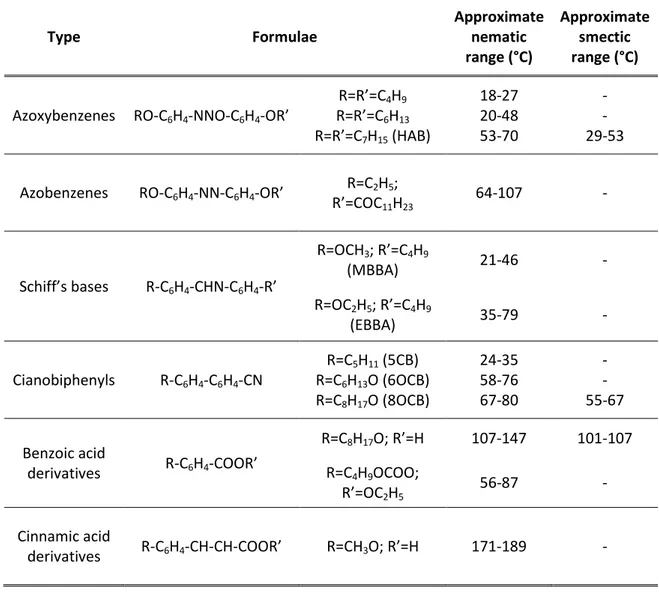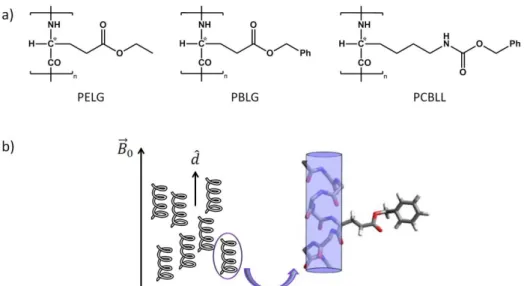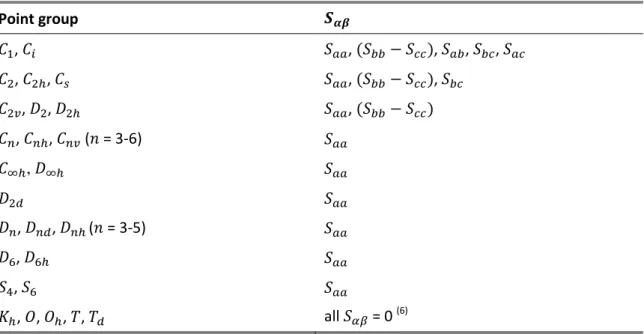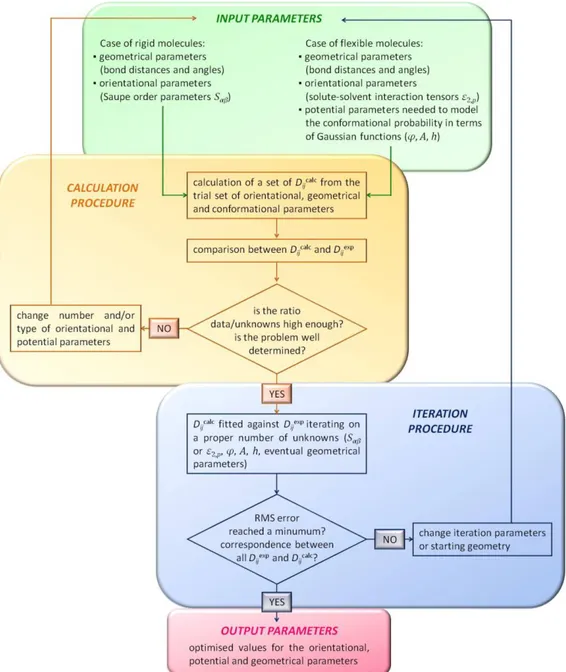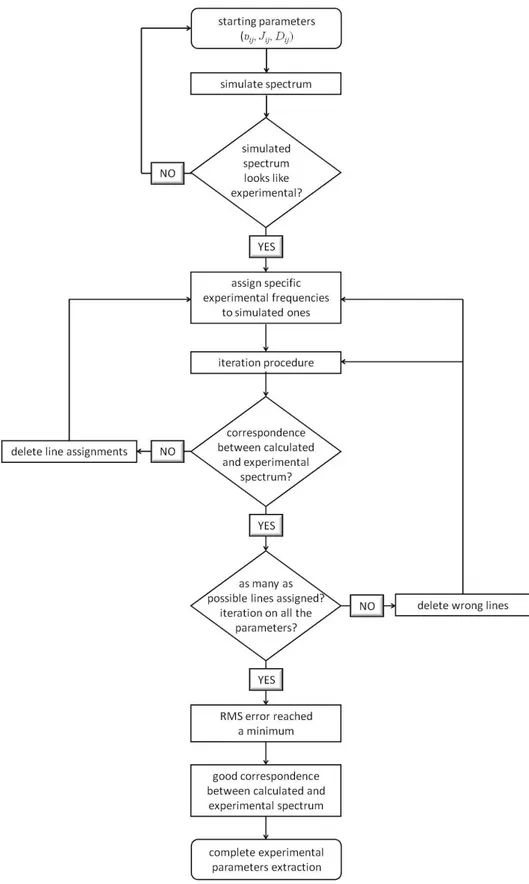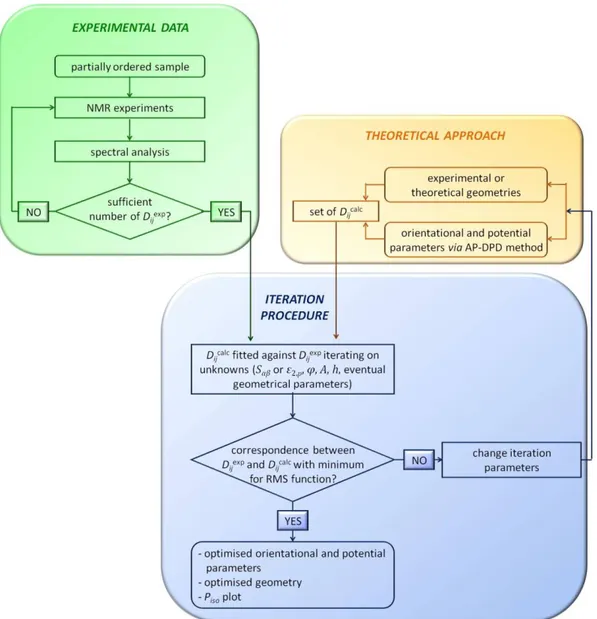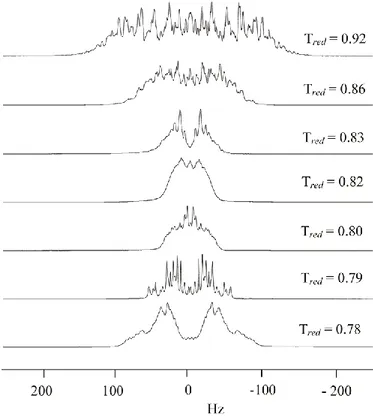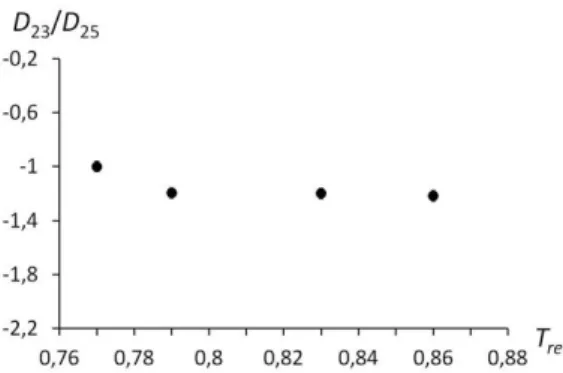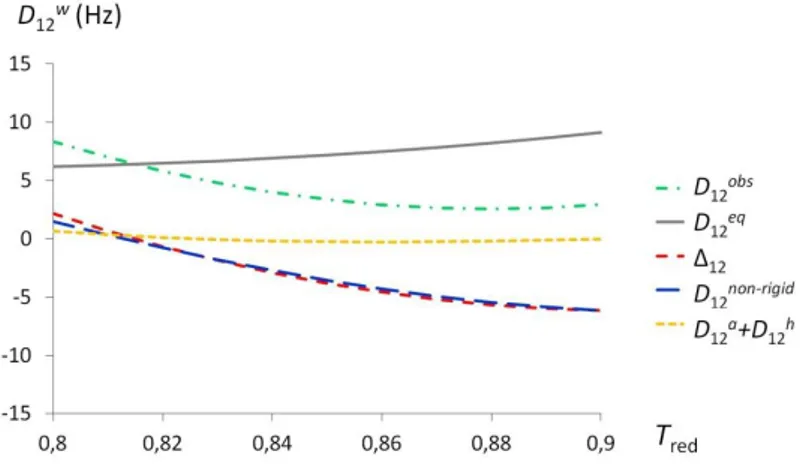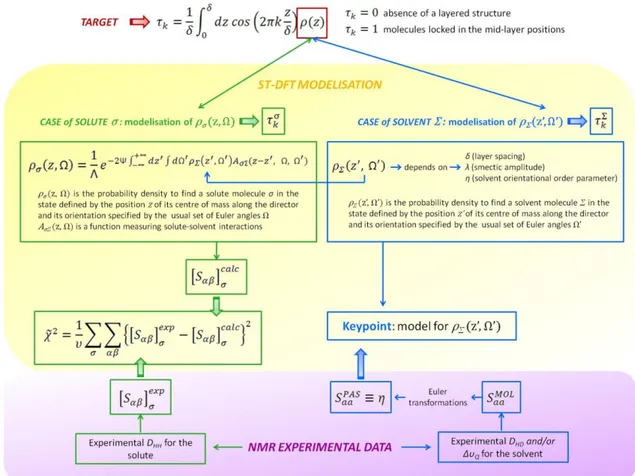La presente tesi è cofinanziata con il sostegno della Commissione Europea, Fondo Sociale Europeo e della Regione Calabria. L’autore è il solo responsabile di questa tesi e la Commissione Europea e la Regione Calabria declinano ogni responsabilità sull’uso che potrà essere fatto delle informazioni in essa contenute.
UNIVERSITE PARIS-SUD
ÉCOLE DOCTORALE: 470 - Chimie de Paris-Sud
Laboratoire de RMN en Milieu Orienté, ICMMO, UMR 8182DISCIPLINE chimie
en co-tutelle avec
UNIVERSITA’ DELLA CALABRIA
ÉCOLE DOCTORALE: Scienza e Tecnica “Bernardino Telesio”
Dipartimento di Chimica e Tecnologie ChimicheDISCIPLINE CHIM/02 – chimie physique
THÈSE DE DOCTORAT
soutenue le 14/12/2013
par
Maria Enrica DI PIETRO
RMN dans différents solvants partiellement
orientés: pour la détermination de la
structure, l’ordre et la conformation
de molécules organiques
Directeurs de thèse: Giuseppina DE LUCA Prof. (Università della Calabria) Denis MERLET Prof. (Université Paris-Sud)
Composition du jury:
Président du jury: Arnold MALINIAK Prof. (Stockholm University) Rapporteurs: Alberta FERRARINI Prof. (Università di Padova)
Burkhard LUY Prof. (Karlsruhe Institute of Technology) Examinateurs: Giuseppina DE LUCA Prof. (Università della Calabria)
Denis MERLET Prof. (Université Paris-Sud) Christie AROULANDA Dr. (Université Paris-Sud)
to those who support me,
without saying a word
Abstract xi
General introduction 1
References 7
Chapter 1. NMR in partially ordered media 9
1.1. Introduction 11
1.2. Partially ordered media for NMR studies 12
1.2.1. Highly ordering media: thermotropic liquid crystals 13
1.2.2. Weakly ordering media 18
1.2.2.1. Lyotropic liquid crystals 19
i. Water-based lyotropic LCs 20
ii. Organic solvents-based lyotropic LCs 21
1.2.2.2. Strained gels 23
1.2.3. Macroscopic and molecular orientational order in a partially
ordered phase 26
1.3. Principles of NMR spectroscopy 28
1.3.1. Nuclear spin Hamiltonian 30
1.3.2. NMR interactions 33
1.4. Relationship between NMR observables and structure, order and
conformational equilibrium 39
1.4.1. Rigid compounds 40
1.4.2. Flexible compounds and conformational problem 44 1.4.2.1. Theoretical approaches describing the interdependent
conformational-orientational problem 48
i. The RIS model 49
ii. The AP methods 51
iii. The ME approach 57
iv. The APME approach 58
1.4.3. Vibrational corrections to dipolar couplings 59
1.5.1. NMR experiments 64
1.5.2. Spectral analysis 66
1.6. Conclusion 71
References 73
Chapter 2. Structural and orientational analysis of rigid molecules 101
2.1. Introduction 103
2.2. Study of highly symmetric rigid solutes in uniaxial nematics: the vibration- reorientation contribution to dipolar couplings in very weak orientational
ordering conditions 105
2.2.1. Analysis of proton and carbon spectra of TMA dissolved in I52 108 2.2.2. Data interpretation and calculation of the order parameter 111 2.2.3. Quantification of the vibration-reorientation contribution 115
2.2.4. Conclusions 119
2.3. Study of rigid probe solutes in smectic phases: determination of positional
order parameters 120
2.3.1. Concise recall of the methodology 122
2.3.2. The smectic A phase of 4,4’-di-n-heptyl-azoxybenzene (HAB) 124
2.3.2.1. Experiments 125
2.3.2.2. Data analysis 132
2.3.3. The partial bilayer smectic Ad phase of
4-n-octyloxy-4’-cyanobiphenyl (8OCB) 134 2.3.3.1. Experiments 135 2.3.3.2. Data analysis 144 2.3.4. Conclusions 147 2.4. Conclusion 148 References 149
Chapter 3. Structural, orientational and conformational analysis of flexible molecules 155
3.1. Introduction 157
3.2. Starting set of dipolar couplings for spectral analysis from molecular
3.2.1. Comparison between experimental and MD simulated results 163
3.2.2. Conclusions 173
3.3. Conformational investigation in solution of anti-inflammatory drugs by
NMR spectroscopy in weakly ordering media 173
3.3.1. Single rotor: diflunisal and its non-fluorinated analogue,
phenylsalicylic acid 177
3.3.1.1. Diflunisal 179
i. NMR experiments. Development of a new gradient encoded SERF experiment for the trivial edition of 1H-19F
couplings 179
ii. Molecular modelling calculations 192
iii. Conformational analysis 193
3.3.1.2. Phenylsalicylic acid 196
i. NMR experiments 196
ii. Molecular modelling calculations 199
iii. Conformational analysis and comparison between the conformational probability distributions of the
fluorinated and non-fluorinated molecule 199
3.3.2. Two and more rotations: profens 202
3.3.2.1. Naproxen 204
i. NMR experiments 205
ii. Molecular modelling calculations 212
iii. Conformational analysis 214
3.3.3. Conclusions 222
3.4. Conformational investigation in solution of stilbenoids by NMR
spectroscopy in highly and weakly ordering media 223
3.4.1. trans-4,4’-Dichlorostilbene and trans-stilbene in ZLI1132 226 3.4.1.1. Synthesis of 4,4’-dichloro-trans-stilbene and NMR
experiments 227
3.4.1.2. Conformational and orientational analysis 233 3.4.1.3. In vacuo theoretical calculations for t-St and
comparison with experimental results 239
3.4.2.1. NMR experiments 242 3.4.2.2. Conformational and orientational analysis 246
3.4.3. Conclusions 249
3.5. Conclusion 251
References 254
General conclusion 277
Appendices 285
Appendix A1. Rotation of reference frames 287
Appendix A2. Structure and main properties of the used liquid crystals 289
Appendix A3. Samples preparation 291
Appendix A4. Optimised geometries of minimum energy conformers of DFL
and APS 293
Appendix A5. Optimised geometry for NAP used in the conformational
analysis 297
Abbreviations 299
Sintesi 303
Résumé 305
List of publications, oral communications and posters 307
NMR spectroscopy in weakly and highly orienting media is used as a route for dealing with orientational, positional, structural and conformational problems of a variety of small rigid and flexible organic molecules in solution.
First, the very weak orientational order of a quasi-spherical molecule dissolved in a nematic phase is exploited for exploring the role of the different contributions to the observed dipolar coupling. In such a limit condition, a predominant effect of the non-rigid reorientation-vibration coupling term emerges. Then, NMR data obtained from small rigid probes dissolved in smectic solvents are combined with a statistical thermodynamic density functional theory, in order to measure the positional order parameters of both solutes and solvent. The methodology gives good results when applied to a conventional smectic A liquid crystal and to the more delicate case of an interdigitated smectic Ad phase.
The strategy is subsequently extended to the investigation of structure, order and conformational equilibrium of flexible bioactive or biomimetic molecules dissolved in various partially ordered NMR solvents. A first experimental and theoretical study is presented on the symmetric single-rotor molecule of biphenyl dissolved in a thermotropic liquid crystal. This test-case indicates molecular dynamics simulations are a promising tool for estimating a set of dipolar couplings of a solute in a thermotropic solvent, to be used as starting set of parameters in a standard operator-mediated NMR spectral analysis. Then, we report the conformational study of some single- and two-rotor nonsteroidal anti-inflammatory drugs, belonging to the families of salicylates and profens, dissolved in weakly orienting chiral nematic PBLG phases. A new pulse sequence, the Gradient Encoded heTeronuclear 1H-19F SElective ReFocusing NMR experiment (GET-SERF), is proposed here for the trivial edition of all 1H-19F couplings in one single NMR experiment, for a given fluorine atom. Starting from homo- and heteronuclear dipolar couplings, difficult to extract in thermotropic solvents because of a too complex spectral analysis, the torsional distributions of such molecules can be satisfactory described by the Additive Potential model combined with the Direct Probability Description of the torsional distribution in terms of Gaussian functions (AP-DPD approach). Finally, the conformational and orientational study of two stilbenoids displaying cooperative torsions is discussed in both a highly and weakly ordering liquid crystal phase. This comparative study allows to draw some conclusions on reliability, accuracy and accessibility of desired data in the two phases.
Overall, this work proves NMR in liquid crystals is a flexible and meaningful tool for studying order, structure and conformation and it can greatly benefit from the availability of several aligning media inducing a different degree of order.
The investigation of molecular properties, namely structure, order and, for flexible compounds, conformational equilibrium, is a crucial goal chemists, physicists and biologists pursue. Among the different techniques available for this purpose, NMR spectroscopy proved, since its first observation in 1945 by Bloch and Purcell, to be “an analytic method of the highest value in the hands of scientists” [1]. Over the decades, the technique gained a leading role for yielding detailed information on the topology, dynamics and three-dimensional structure of molecules, both in solution and in solid state, in a large variety of disciplines of natural science, from solid state physics to chemistry, biochemistry, biology, pharmaceutics, medicine and food science [2-3]. Its potentiality is further risen when it is combined with the use of partially ordered media, where molecules take up a preferred orientation with respect to the magnetic field [4-5]. Thanks to the peculiar dualism “flow-anisotropy” of these media, anisotropic interactions can be observed, even if partially averaged by molecular motions, with a quite high resolution. Indeed, these second-rank tensor quantities, averaged to zero in isotropic liquids by brownian motions, are the observables that, in anisotropic phases, do allow to extract the desired information. We have, in other words, a gateway giving direct access to molecular properties in solution. Out of the four anisotropic observables - chemical shift anisotropy, anisotropy of indirect coupling, direct dipolar coupling and quadrupolar splitting, - mainly dipolar couplings have been recognised to contain a unique wealth of structural, orientational and conformational data, thanks to their dependence on the spin-spin distances and on the orientations of the internuclear vectors with respect to the external magnetic field [4-5]. In the last 50 years, the NMR technique in partially ordered media has been largely applied both to investigate structure, order and dynamics of mesogenic molecules and to study solutes dissolved therein, with the aim of directly exploring their molecular properties or of using them as indirect probes of solute-solvent interactions and/or phase properties. At the beginning the anisotropic observables were essentially used for the determination of very accurate structural and orientational parameters in small rigid molecules dissolved in highly ordering liquid crystals. The technique was later extended to the study of small symmetric flexible compounds, where the description of conformational equilibrium, more than structural and orientational information, was the main target. The current interest moves towards more and more complex, large and asymmetrically substituted flexible molecules and this trend is particularly marked for biomolecular systems. However, if intramolecular dipolar couplings represent the “door” towards all these molecular properties, we need a “key”, that is a tool able to translate the experimental data enclosed in NMR spectra into the desired physical information. Indeed, orientational order and conformational distribution are inextricably linked together. As a result of this interdependence, theoretical models are
needed in order to relate the experimental set of dipolar couplings to structure, order and conformational equilibrium of the molecule of interest [6]. A series of theoretical approaches have been proposed in the past for solving this problem and among them one of the most useful is a combination of the Additive Potential model [7] with the Direct Probability Description of the torsional distribution [8].
The orienting media used almost exclusively up to the mid-1990s include thermotropic liquid crystals, mainly nematic ones, which induce a rather high degree of alignment to the solute. Spectra of organic molecules dissolved therein consist of thousand of lines evenly dispersed in the kHz range, due to intramolecular dipolar interactions among all magnetically active nuclei in the molecule, carrying highly precise information. Despite the extremely informative content, spectral analysis is not trivial and requires graphical iterative procedures, where the availability of a good set of starting parameters represents the crucial step. With the increase in the size of the spin network and the decrease in molecular symmetry, the determination of the dipolar coupling set becomes problematic and this is the reason why the technique was traditionally limited to highly symmetric molecules with no more than 8-10 spins [4-6]. An appealing alternative came with the advent of orienting media that induce a lower degree of order compared to thermotropic mesophases. In weakly ordering phases, anisotropic interactions are averaged significantly but not entirely, so that the dipolar couplings can be scaled down from many kHz to a few Hz and the spectral quality of high-resolution NMR spectra is retained. Hence, these so-called residual dipolar couplings (RDCs) make it possible to access structural and conformational information even for large compounds with low symmetry. During the years several aligning media with a low-order parameter for molecules soluble in polar or non-polar media have been reported and successfully applied to the structural study and enantiomeric discrimination of a variety of compounds [9-12]. Among them, the chiral liquid crystalline phases made of poly-γ-benzyl-L-glutamate (PBLG) dissolved in helicogenic organic solvents are probably the most popular [13]. Despite the spreading success obtained by weakly orienting media, it should be remembered they may have some drawbacks, too. First, although the information accessibility seems to be easier than in highly ordering liquid crystals, the extraction of a large set of couplings often requires performing several multidimensional experiments and in some cases developing ad hoc pulse sequences. Additionally, since the size of couplings is tremendously reduced compared to strongly orienting systems, only the largest dipolar couplings between the nearest nuclei can be practically measured and the percentage error in the extracted data is supposed to be higher than in thermotropics. Generally speaking, two main philosophies have been individuated [9]. One is the “physicists’ approach”: the central idea is to learn as many
details as possible about a molecule in solution, in order to disclose fundamental accurate understanding of molecular arrangements and motions. In this case, thus, the molecule should be aligned as strongly as possible to give valuable long-range dipolar couplings. The second one is the “chemists’ approach”: the goal here is to get limited information of more complex molecules for solving specific constitutional and configurational questions. In this case, one works with very weakly aligning samples, where relatively small RDCs are available, but with sufficiently resolved spectra also to look at complex organic molecules as spin networks. The two approaches should not be considered antithetical, but rather complementary. Indeed, the possibility of following one philosophy rather than the other, i.e. of choosing between highly and weakly aligning media, makes NMR spectroscopy a flexible and versatile tool able to face multiple issues and to obtain molecular information in various systems, while taking into account each time the balance between difficulty in spectral analysis versus extent and precision of the data set.
The basic idea of this Ph.D. thesis will be then the use of NMR spectroscopy of a variety of small organic molecules dissolved in different partially ordered media as a route for (i) treating orientational and positional problems in systems composed of rigid compounds in uniaxial highly orienting nematic and smectic phases, and (ii) exploring 3D structure and conformational equilibrium of flexible bioactive molecules as solutes in highly and/or weakly aligning media. The discussion will be organized into three chapters.
An overview on the basic tools of NMR spectroscopy in partially ordered media will be given in the first chapter, with a recall of all NMR interactions and their relationship with structure, order and conformational equilibrium, along with a survey of the main theoretical models required to unlock such an extremely valuable information content. Moreover, the main classes of aligning media will be described, giving more emphasis to thermotropic LCs and PBLG phases that are used in this thesis. We will end with a discussion of the peculiar NMR methodologies necessary for recording and analysing NMR spectra of solutes dissolved in these two classes of solvents.
The second chapter will focus on the ordering behavior in highly orienting thermotropic phases. In the first part, we will study the highly symmetric molecule of tetramethylallene dissolved in the I52 nematic phase, with the aim of exploiting such a limit condition of very small orientational order to explore the role of reorientation-vibration coupling on the observed dipolar coupling. In the second part, NMR data obtained from small rigid probes dissolved in smectic solvents will be combined with a statistical thermodynamic density functional theory (ST-DFT) in order to measure the positional order parameters of both
solutes and solvent. The methodology will be applied to the conventional smectic A liquid crystal HAB and to the more delicate case of the interdigitated smectic Ad liquid crystal 8OCB.
In the third chapter the attention will be moved to flexible molecules, whose structure and conformational equilibrium will be investigated when dissolved in various liquid crystalline phases. The elucidation of the spatial arrangement of flexible organic chemicals in solution is a common target for the scientific community and this is especially true in life science and medicinal chemistry. Indeed, bioactivity and 3D structure are often intimately related. NMR in oriented phases reveals in this context particularly useful when classical NMR structural determination by short-range 3J-coupling constants or nOe measurements fails in refining the spatial distribution of molecular sites that are far apart. In this last chapter a clearer picture will emerge about the different problems one has to face and the quality of the results one can get in the conformational analysis of a solute dissolved in a highly or weakly ordering phase. First, we will present a comparative study - NMR experiments versus molecular dynamics (MD) simulations - of the symmetric single-rotor molecule of biphenyl dissolved in the thermotropic 8CB liquid crystal. This well-studied molecule is chosen as test for evaluating the predictivity of MD in simulating dipolar couplings of solutes in highly ordering media, to be used as starting set of parameters for the iterative operator-mediated spectral analysis. Second, we will address the conformational investigation of some more complex anti-inflammatory molecules. Due to the asymmetry and large spin system of these drugs, PBLG-based mesophases will be used as solvent for all studies. Thanks to the small magnitude of dipolar couplings, a broad array of 1H, 13C, 19F and 2H 1D and 2D experiments are performed - or even designed - for samples of diflunisal (and its non fluorinated analogue) and naproxen, in order to collect an experimental data set as large as possible. The torsional distribution of these single- and two- independent rotor molecules will be described by the AP-DPD approach. Finally, the conformational and orientational study of two stilbenoids, trans-stilbene and trans-4,4’-dichlorostilbene, displaying two cooperative torsions, will be discussed in both a thermotropic and a lyotropic phase. From this final comparison it will be possible to draw some interesting conclusions on reliability, accuracy and accessibility of conformational information in highly and weakly ordering phases.
References
[1] Les Prix Nobel en 1952, G. Liljestrand ed., Nobel Foundation, Stockholm, 1953
[2] Modern Magnetic Resonance, G. A. Webb ed., Springer, Dordrecht, The Netherlands, 2006, ISBN: 9781402038945
[3] R. R. Ernst, Recent development in NMR methodology for the study of molecular structure and dynamics, Pure Appl. Chem., 66, 1994, 1583-1588
[4] NMR of Ordered Liquids, E. E. Burnell, C. A. de Lange eds., Kluwer Academic, Dordrecht, 2003, ISBN: 1402013434
[5] Nuclear Magnetic Resonance of Liquid Crystals, J. W. Emsley ed., Reidel, Dordrecht, 1985, ISBN: 9027718784
[6] J. W. Emsley, Liquid crystalline samples: structure of nonrigid molecules, in Encyclopedia of Magnetic
Resonance, John Wiley & Sons, Ltd, 2007
[7] J. W. Emsley, G. R. Luckhurst, C. P. Stockley, A theory of orientational ordering in uniaxial liquid crystals composed of molecules with alkyl chains, Proc. R. Soc. Lond. A, 381, 1982, 117-138
[8] G. Celebre, G. De Luca, J. W. Emsley, E. K. Foord, M. Longeri, F. Lucchesini, G. Pileio, The conformational distribution in diphenylmethane determined by nuclear magnetic resonance spectroscopy of a sample dissolved in a nematic liquid crystalline solvent, J. Chem. Phys., 118, 2003, 6417-6426
[9] G. Kummerlöwe, B. Luy, Residual dipolar couplings as a tool in determining the structure of organic molecules, Trends Anal. Chem., 28, 2009, 483-493
[10] C. M. Thiele, Residual dipolar couplings (RDCs) in organic structure determination, Eur. J. Org.
Chem. 2008, 5673-5685
[11] J. Yan, E. R. Zartler, Application of residual dipolar couplings in organic compounds, Magn. Reson.
Chem., 43, 2005, 53-64
[12] J. Courtieu, P. Lesot, A. Meddour, D. Merlet, C. Aroulanda, Chiral liquid crystal NMR: a tool for enantiomeric analysis, in Encyclopedia of Nuclear Magnetic Resonance, vol. 9: Advances in NMR, D. M. Grant, R. K. Harris eds., John Wiley & Sons, Ltd, Chichester, UK, 2002
[13] E. T. Samulski, A. V. Tobolski, Some unusual properties of poly(y-benzyl L-glutamate) films cast in strong magnetic fields, Macromolecules, 1, 1968, 555-557
Chapter 1
1.1. Introduction
NMR spectroscopy is currently recognised as an extremely powerful technique to obtain detailed information on the topology, dynamics and three-dimensional structure of molecules both in solution and solid state as well as on the solute-solvent interaction nature. In isotropic liquids, the brownian motions average all anisotropic spin interactions to zero, yielding quite simple and well resolved spectra. On the other hand, in solids, that are “fully oriented”, intra- and intermolecular interactions are present, and this results in broad and featureless spectra, which contain yet plenty of information. Only in 1963, when Saupe and Englert reported the first highly resolved spectrum in a liquid crystalline solvent [1], a smart compromise could be achieved and the potential usefulness of a study of solute molecules in liquid-crystalline phases became evident [2]. Since then, many different alignment media have been published for various applications. The uniqueness of this approach is that in partially ordered media molecules still rotate and diffuse as in normal liquids, but, owing to their anisotropic interactions, they are partially oriented [3-4]. The diffusion and rotation are responsible for the averaging out of intermolecular direct dipolar coupling so that we observe the “isolated” spins system of one molecule. Since the motion of the molecules does not deviate appreciably from that of normal liquids, linewidths of the order of few Hertz can be obtained. Therefore, anisotropic interactions can be measured with considerable accuracy. Among them, residual dipolar couplings (RDCs) have come to occupy a leading position since they provide access to incomparable information about molecular structure, orientation and conformation [3, 5-6].
The aim of this chapter is to present a rapid overview on the basic tools of NMR spectroscopy in partially ordered media. In section 1.2 we will briefly describe the main classes of aligning media, focusing principally on those used in this thesis. A recall of the theoretical principles of NMR spectroscopy, including the description of all the NMR interactions, will be given in section 1.3. The relationship existing between such anisotropic observables and the structure, order and conformational equilibrium will be described in section 1.4, where the theoretical models required to unlock such an extremely valuable information content will be also presented. Finally section 1.5 will display the NMR methodology necessary for recording and analysing NMR spectra of solutes dissolved in partially ordered media.
1.2. Partially ordered media for NMR studies
What makes partially ordered media exceptional materials for NMR studies is that they provide a unique balance between the order of solids and the flow of liquids [7-9]. Indeed, molecules in partially ordered media diffuse about much like the molecules of a liquid but concomitantly they maintain some degree of orientational order and sometimes some positional order too [10]. The amount of ordering is quite small relative to a crystal: there is only a slight tendency for the molecules to point more in one direction than others. This preferred direction is called director and is denoted by . In the absence of aligning forces the director is not constant over large volumes but varies smoothly throughout a sample without discrete changes, hence one often speaks of the director field , where is the space coordinate [9]. Broadly speaking, when a partially ordered phase is put into the magnetic field , the latter will induce a uniform order in the mesophase so that the preferred orientation, the director , is the same for the whole sample [11]. The orientation dependent free energy of the interaction, , between the magnetic field and the mesophase can be expressed as [12]: where is the difference between the magnetic susceptibility parallel and perpendicular to the director (that is the anisotropy in the bulk diamagnetic susceptibility) and is the angle between the director and the magnetic field. The direction of minimal , that is the preferred alignment, will depend on the quantity [11]: if is positive will align along ( is zero to give a minimum free energy), if is negative the perpendicular orientation is preferred ( = π/2 to give a minimum free energy). Fluctuations in the alignment are always present so that a more or less peaked distribution around the direction of the preferred alignment is obtained depending also on the strength of .
There are in principle many different possible ways to classify ordered media. For the purpose of this thesis the degree of alignment they induce on a solute dissolved therein rather than their structural properties will be underlined. For this reason, we distinguish between highly ordering and weakly ordering media. Whereas only thermotropic liquid crystals are known to induce a strong alignment, a broad array of phases inducing weak alignment of the solute molecule has been published. Among them we will give a concise description for the main classes, namely lyotropic liquid crystals and strained gels.
From the above, the needful features for a medium to be used as solvent in NMR studies are: (i) ability to be ordered in a magnetic field and (ii) ability to induce order to solutes dissolved therein. Looking at materials available in literature, many examples of anisotropic
phases that order homogenously in a magnetic field can be found among synthetic liquid crystal polymers [13-14], carbon nanotubes [15-18], ionic liquid crystals (such as ammonium, phosphonium, imidazolium, pyridinium, vinamidinium, and dithiolium salts) [19-24] or chromonic liquid crystals [25-27]. It may be interesting in the future to evaluate whether such ordered phases are also able to induce a detectable order to a solute dissolved therein and if, eventually, they could offer some advantages with respect to the already available NMR ordered phases.
1.2.1. Highly ordering media: thermotropic liquid crystals
Two main classes of liquid crystal (LC) exist, thermotropics and lyotropics. The former induces a high degree of orientational order for a solute dissolved inside the mesophase, while the latter will be considered in the next section, among the weakly ordered media.
Thermotropic liquid crystals are built up by individual molecules and no further molecular species (specifically solvent molecules) are required for the liquid crystal phase formation. Temperature is the fundamental thermodynamic control parameter determining the phase, the two key temperature values being those defining the beginning and the end of liquid crystalline order, the melting point Tm from the crystalline solid and the clearing point Tc into an isotropic liquid [28]. Typical thermotropic liquid crystalline molecules have either a rod-like (or calamitic) or disk-rod-like (or discotic) shape (Figure 1.1), but many exceptions on this basic motif have been described, such as sanidic (or lath-like or board-like) liquid crystals [29-30], bent-core (or banana-shaped) liquid crystals [31-35] and LC dendrimers [36-38].
Depending on the arrangement of molecules and the degree of order, thermotropic liquid crystals can show different supramolecular assemblies. The nematic phase (abbreviated N or ND, for rod-shaped and disc-shaped molecules, respectively) is the least ordered mesophase that generally precedes the isotropic transition temperature. In this phase long-range order is of purely orientational type: the anisometric building blocks (rods or discs) are roughly oriented along one and the same direction, the director (Figure 1.2). At the microscopic level, these molecules are mobile and their centers of mass are distributed at random throughout the volume. In other words, these molecules do not have any positional order [4, 9].
Figure 1.1. Representations of typical rod-like (4-pentyl-4’-cyanobiphenyl, 5CB, on the left) and disk-like (hexa-peri hexabenzocoronene, HBC-C6, on the right) mesogen molecules at different levels of precision: (a) topological structure, (b) “balls” representation and (c) classical schematic picture.
When both orientational long-range and positional order are observed, the phase is called smectic for rod-shaped molecules and columnar for disk-shaped ones.
In smectic phases, rod-shaped molecules are arranged parallel to each other and are separated into layers such that their long axes preferentially point in the same direction. The degree of positional order is still not very high and molecules frequently move from one layer to the next [9, 28]. Smectics are further classified depending on the molecular arrangement within and between the layers (smectic A, B, C etc) (Figure 1.3).
Figure 1.2. Molecular organization in a nematic phase composed of (a) rod-like and (b) disk-like molecules. The order degree is strongly exaggerated.
Figure 1.3. Molecular organization in the (a) smectic A and (b) smectic C phases. (c) Molecular arrangement of apolar or polar constituents of smectic layers in a monolayer SmA, bilayer SmA2 and interdigitated bilayer SmAd phase. (d) Schematic representation of the short-range ordering organization within the hexagon layers of a smectic B, smectic F and smectic I phase. In SmB phase, molecules are perpendicular to the smectic plane and are indicated by circles, while in SmF and SmI phases mesogens are tilted, with the major axis of the ellipse indicating the molecular tilt direction with respect to the hexagon axes. In all figures the order degree is strongly exaggerated.
For the smectic A (SmA) phase, the least ordered smectic phase, the director points along the smectic layer normal. The molecules are arranged randomly within each layer, and they have a considerable freedom for rotation around their long axis and even for translation in the smectic layer. Two modified forms of the conventional non-polar monolayer smectic A phase are generated when the constituent molecules contain strong dipole moments [39-41]: the bilayer smectic A2 phase, where the molecules are arranged up to down within each layer producing a periodicity equal to twice the molecular length; the interdigitated bilayer smectic Ad phase, with molecules tending to pair up in a slipped-parallel configuration. The smectic C phase (SmC) is very similar to the smectic A phase but with the difference that the director makes an angle, the so-called tilt angle, with the smectic layer normal [10]. In the smectic B
phase (SmB or hexatic B phase) the symmetry within the layers is higher than A or C [9-10]: there is a 6-fold bond orientational order, which means that the lattice orientation is retained in the layers, but the translational order is lost within a few intermolecular distances. The hexagonal nature of the SmB phase generates two tilted analogues called the smectic I (SmI) phase and the smectic F (SmF) phase, where the molecules are tilted such that the hexagonal lattice tilts toward the apex and the side, respectively [10].
The columnar phase (Ncol) is typically formed by discotic mesogens, stacked in order to form columns as in piles of coins. The columns themselves can be arranged in different two-dimensional lattices (Figure 1.4). In the hexagonal columnar phase (Dh) the molecules are stacked into columns that are further arranged into a hexagonal lattice [10]. The lattice distance from a molecule to its nearest neighbour is identical whatever the direction. Another types of columnar phases is the rectangular columnar phase (Dr), characterized by a rectangular unit cell. The lattice distance from a molecule to its nearest neighbour is directional [10].
Figure 1.4. Molecular organization in a nematic columnar, hexagonal columnar and rectangular columnar phase. The order degrees (orientational and positional) are strongly exaggerated.
When optically active mesogens are used or chiral non-mesogenic dopants are added to a liquid crystal phase, the macroscopic liquid crystal phase is also chiral (this is generally indicated by adding a star to the shorthand of the corresponding achiral phase). The best studied chiral liquid crystal is the chiral calamitic nematic phase, N*, often referred to as the cholesteric phase, since many of the first compounds that possessed this phase were derivatives of cholesterol [10]. In such phases the director rotates in helical fashion about an axis perpendicular to the director (Figure 1.5). The pitch of the N* phase is the distance along the helix over which the director rotates by 360° [10]. Note however that the structure repeats itself every half pitch due to the equivalency of and .
The chiral discotic nematic phase (ND*) has an analogous structure to the calamitic chiral nematic phase with a gradual rotation of the molecular director through the phase
which describes a helix [10]. In smectic A phases, a helical director modulation perpendicular to would break the layers and is thus not normally admitted (an exception is the rare class of twist-grain boundary phases) [28]. The SmA* phase therefore has the same structure as an achiral SmA phase, but it shows interesting paraelectric properties unlike its achiral analog [28]. In contrast to SmA*, the chiral SmC* phase does allow a helical superstructure, but it applies to the direction along which the molecules tilt away from the layer normal. In other words, in SmC* does not twist as in N*, but rotates around the cone generated by the tilt angle as the position along the normal to the layers is varied [10, 28, 42]. The SmC* phase exhibits a spontaneous polarization and can thus shows ferroelectric and antiferroelectric switching properties [43]. More recently, chiral discotic materials that exhibit tilted columnar mesophases have attracted attention too [10].
Figure 1.5. Calamitic nematic (or cholesteric) phase.
Out of the different types of thermotropic liquid crystals, nematics are the most commonly used as solvents in high resolution NMR studies since they are the least ordered and enjoy low viscosity and high mobility [4, 9]. Since nematic phases have densities and viscosities of the same order of the most common isotropic liquids, solutes in such anisotropic phases are usually considered to share the same behavior in terms of structure and conformation as in ordinary liquid phases. This issue is quite important and different opinions about the point can be found in literature [44]. Smectic and columnar phases are rarely used as NMR solvents, mainly because of their very high viscosity path [4]. Cholesterics also are not routinely used as solvents in NMR studies, probably owing to difficulty in their alignment [4], although their use may be an advantage in studying the optically active solutes [45]. In the choice of the most suitable thermotropic liquid crystal for NMR studies, attention should be paid on the two key temperature values Tm and Tc. In fact, in order to easily handle the sample, i.e. to obtain homogeneous samples and consequently resolved spectra, the liquid crystalline range should occur around room temperature. Additionally, it is easily understandable that the
choice of the liquid crystal for a particular NMR study strongly depends on the solubility of the solute. In Table 1.1 are listed some of the most commonly used thermotropic mesophases, together with their transition temperatures.
Table 1.1. Examples of thermotropic nematic liquid crystals used as NMR solvents.
Type Formulae Approximate nematic range (°C) Approximate smectic range (°C)
Azoxybenzenes RO-C6H4-NNO-C6H4-OR’
R=R’=C4H9 R=R’=C6H13 R=R’=C7H15 (HAB) 18-27 20-48 53-70 - - 29-53
Azobenzenes RO-C6H4-NN-C6H4-OR’ R=C2H5;
R’=COC11H23 64-107 - Schiff’s bases R-C6H4-CHN-C6H4-R’ R=OCH3; R’=C4H9 (MBBA) 21-46 - R=OC2H5; R’=C4H9 (EBBA) 35-79 - Cianobiphenyls R-C6H4-C6H4-CN R=C5H11 (5CB) R=C6H13O (6OCB) R=C8H17O (8OCB) 24-35 58-76 67-80 - - 55-67 Benzoic acid derivatives R-C6H4-COOR’ R=C8H17O; R’=H 107-147 101-107 R=C4H9OCOO; R’=OC2H5 56-87 - Cinnamic acid derivatives R-C6H4-CH-CH-COOR’ R=CH3O; R’=H 171-189 -
1.2.2. Weakly ordering media
A wide array of aligning media inducing a low degree of order does exist. In the following, only the main families will be described, even if many other methods for the weak alignment of solutes are actually employed, such as purple membrane fragments [46-48], the use of thermotropic liquid crystals close to their clearing point [49], methods of orientation of macromolecules via paramagnetic ions and tags [50-53] and the alignment of biomolecules as
a result of their own magnetic susceptibility anisotropy [54-56]. For a brief summary of some selected weakly ordered solvents see Table 1.2.
1.2.2.1. Lyotropic liquid crystals
The most widely used weakly ordered media are lyotropic liquid crystalline phases, which are composed, in contrast to thermotropic mesophases, of at least two components: a “liquid crystal builder”, which is responsible for the anisotropic behaviour, and a solvent, that is generally polar (mainly water) but can also be apolar. For these compounds, the concentration is as important, if not more important, than the temperature in determining whether a liquid crystal phase is stable [10].
The standard constituent molecules of the liquid crystal builder are typically amphiphilic but lyotropic liquid crystals can form also by anisometric non-amphiphilic macromolecules or particles such as viruses or inorganic rods or disks in colloidal suspension. At extreme dilution, the constituent compounds are distributed randomly throughout the solution and interact only transiently with each other [57]. As their concentration is increased, molecules start aggregating and at a concentration known as critical micellar concentration, aggregates of the molecules begin to form stable semispherical entities known as direct or reversed micelles [10] (Figure 1.6).
Figure 1.6. Cross sections of (a) direct and (b) reversed spherical micelles.
With a continued increase in the concentration of the constituent compound, a variety of differently shaped aggregates forms, so that several lyotropic liquid crystal phases (hexagonal, lamellar, cubic) are observed. Their description is out of the scope of this work and the reader is referred to references for more information [10, 57-60].
Compared to thermotropic systems, a remarkable advantage of lyotropic LCs is that the order induced can be manipulated within certain borders since it varies with the
concentration of the liquid crystal builder. Nevertheless, it has to be noted that the existence of a critical concentration imposes a lower concentration limit below which the liquid crystalline phase is disrupted.
i. Water-based lyotropic LCs
A large amount of lyotropic phases are known for water soluble compounds and this explains why RDCs have been extensively used in biomolecular NMR spectroscopy [56, 61-67]. Among them we just recall:
- Lipid bicelles, formed by planar phospholipid particles, like mixtures of dimyristoyl phosphatidylcholine (DMPC) and dihexanoyl phosphatidylcholine (DHPC), in aqueous buffer [68-71]. Their use has greatly improved the accuracy in the structural determination of biologically interesting macromolecules and in the study of intermolecular interactions [72-74].
- Surfactant/n-alkyl alcohol mixtures, namely aqueous solutions of cetylpyridinium chloride (CPCl) or cetylpyridinium bromide (CPBr) and n-hexanol [75-76] or mixtures of n-alkyl poly(ethylene glycol)/glucopone and n-alkyl alcohol (the so-called Otting phase) [77].
- Rod-shaped negatively charged virus, like the filamentous bacteriophage Pf1 [78-80], the bacteriophage fd [81-82] and the tobacco mosaic virus [82].
- DNA nanotubes [83] and crystalline phase G-tetrad DNA [84]. Unlike previous lyotropic phases, they show the advantage of being compatible with the solvents typically used to solubilise membrane proteins for structural study.
- Cellulose crystallites in aqueous suspensions [85-87].
- Mineral lyotropic liquid crystals, such as V2O5 (vanadium pentoxide) [88-89] or H3Sb3P2O14 [90]. Important to note is that they might change the conformational equilibrium in flexible domains of the molecule studied. Although this result is not causing a problem for the structure determination of large structured biomolecules, the alignment tensor of small molecules might change.
ii. Organic solvents-based lyotropic LCs
Although widely used to align biomolecules, lyotropic LCs were not as extensively exploited at the beginning for the analysis of small organic molecules [5, 91-92], principally because the traditional aligning media were only applicable to water-soluble compounds. In order to be able to partially align small molecules that are typically insoluble in water, it is necessary to have access to orienting media compatible with organic solvents.
The first available lyotropic media based on organic solvents were the chiral liquid crystalline phases made of homopolypeptides, namely γ-benzyl-L-glutamate (PBLG), poly-γ-ethyl-L-glutamate (PELG), or poly-ε-carbobenzyloxy-L-lysin (PCBLL), dissolved in helicogenic organic solvents, introduced as NMR solvents first in the mid 1990s [93-102]. In helicogenic cosolvents the main chain of the synthetic polypeptide adopts a rigid chiral -helical conformation, while the substituted aminoacid (glutamate or lysin) side chains, which branch from the main helix, may also form a secondary molecular helix [103-104]. Spontaneously, the chiral fibers orientate to form a macroscopic, supramolecular helical structure of directors in the mesophase, typical of that exhibited by cholesteric liquid crystals. When submitted to a routine NMR magnetic field, the supramolecular helix unwinds, and the system behaves like a chiral nematic phase with positive anisotropy of the molecular diamagnetic susceptibility, with the director homogeneously aligned parallel to the static magnetic field [96, 105-106]. It can then be considered as parallel rods (formed by the -helices of the main chain, pointing in the direction of the magnetic field) with glutamate/lysin side chains pointing out into the interstices between the rods [107] (Figure 1.7). The solute molecules are oriented in these interstices.
First advantages of homopolypeptides are their chemical inertness and ready commercial availability with high degree of polymerisation (DP) which ensures the existence of a large liquid-crystalline phase range. An additional benefit is that both the organic molecule of interest and polypeptide are readily soluble in common low viscosity organic solvents [96, 108-109]. This allows orientational information to be accessible for small organic molecules that have little or no solubility in aqueous based alignment systems. Note that the organic co-solvent employed has to homogeneously dissolve the polypeptide and preserve the -helical structure of the polymer [96]. Therefore, trifluoroacetic acid and DMSO, for instance, are not suitable co-solvents since they form strong intermolecular hydrogen bonds with the polypeptide chain, giving rise to a random coil conformation for the polymer, and consequently, the liquid crystalline properties of the solvent disappear [96, 109].
Figure 1.7. (a) Structural formulae of the chiral homopolypeptides poly-γ-benzyl-L-glutamate (PBLG), poly-γ-ethyl-L-glutamate (PELG), and poly-ε-carbobenzyloxy-L-lysin (PCBLL), and (b) the uniaxial nematic chiral liquid crystalline phase they create when dissolved in helicogenic organic solvents.
Probably the most exploited advantage of the LC phases made of homopolypeptides is their chirality, which formed the basis for the impressive work on enantiodiscrimination done first by the precursor group of Courtieu [110-120]. This property arises because the difference in the enantioselective interactions between the S and R isomers and the chiral liquid crystal generally generates a differential ordering effect (DOE) large enough to discriminate between them using order-sensitive NMR observables [97, 100, 121]. This method is found to be useful not only for systems that possess a chiral center but also for those that exhibit enantiomerism due to the presence of either a chiral axis or a chiral plane [122] and also for atropisomers [123]. Besides enantiodiscrimination, the chirality of the LC phase would, in principle, allow the determination of the absolute configuration without any derivatisation [124]. However, this is possible only if supplementary data, as the interaction of liquid crystal and single enantiomers, are known precisely in addition to NMR observables [125].
As seen above, the main disadvantage of lyotropic liquid crystalline systems is their limitation to certain concentration ranges. Indeed, this is especially true for polypeptidic lyotropic LCs since most of them align very strongly for medium-sized organic molecules even at the lower concentration limit. However, RDC amplitudes can be monitored by means of the so-called Variable Angle Sample Spinning (VASS) [126-128], which consists in spinning the sample close to the magic angle, thus reducing the magnitude of RDCs.
Recently, in the wake of the success gained by homopolypeptides, a new class of one-handed helically chiral non-racemic polymers suitable for the orientation of organic
compounds and the discrimination of enantiomers, have been proposed, including polyisocyanates [129-131], polyacetylenes [132-134], polyisocyanides [135-137], and polyguanidines [138-140]. The major drawback of these new compounds is that signals from solvents may hide those from solutes unless deuterated polymers are synthesized.
1.2.2.2. Strained gels
A conceptually different approach of inducing order is the SAG method, Strain induced Alignment in a Gel [141-143]. A common preparation scheme consists in introducing a dry polymer cylinder into an NMR tube which is then swollen by adding a solvent. Initially, the gel has pores that can be considered spherical. Homogeneous mechanical stress of the gel distorts the pores and induces partial orientation of dissolved molecules. Two main procedures can be applied to induce strain into the gel:
a) vertical stress, compression: by pushing the plunger of a Shigemi tube onto the gel which has a slightly smaller diameter (0.5 mm) than the inner diameter of the NMR tube, at the end of the reswelling process. As a consequence, the cavities in the gel will be oblate with their normal axis in the direction of the tube.
b) radial stress, stretching: by squeezing into a regular NMR tube a gel originally polymerized in a tube of larger diameter than the sample tube. In this case, the gel in the swollen state has an equilibrium diameter larger than the inner diameter of the NMR tube, so that the swelling is confined by the glass walls of the NMR tube (Figure 1.8). This results in prolate shaped pores. Radial compression can be also obtained via a commercially available device [144].
A series of different gels is currently available for the measurement of RDCs in compounds soluble both in aqueous solutions (stretched poly(acrylamide) (PAA) [143, 145-146], charged poly(acrylamide) derivatives [147-149], collagen-based gelatin [150-153] and collagen itself [154-155]) and in organic solvents (poly(vinylacetate) (PVAc) [156], polystyrene (PS) [142, 157], poly(dimethylsiloxane) (PDMS) [158], poly(methylmethacrylate) (PMMA) [159], poly(acrylonitrile) (PAN) [160], PH-poly(dimethylacrylamide) (PH-PDMAA) [161] and polyurethane (PU) [162]). Very recently, poly(ethyleneoxide) (PEO) cross-linked with γ-irradiation (γ-PEO) and chemically cross-linked (PEO-methylmethacrylate, PEOMMA) has been proposed as alignment medium possessing exceptional compatibility with both polar and nonpolar solvents [163].
The main advantage of SAG media in comparison to liquid crystalline solvents is that the order induced is independent of the strength of the magnetic field and there is no critical concentration below which phase anisotropy is lost. Therefore, RDCs can be modulated at will by varying the degree of cross linking of the gel [156-160] and by mechanically compressing or stretching the gel within the NMR sample tube, both in highly polar [151-152, 164-165] and apolar solvents [160, 166]. Other advantageous features of SAG include its effectiveness over wide ranges of temperature, pH, and ionic strength. One major drawback, however, is that, although a chiral gelatin-based SAG medium for water soluble molecules has been reported [150, 152, 167], there is, to the best of our knowledge, no chiral SAG medium based on organic solvents. Another remarkable disadvantage of stretched gels is the long time that is sometimes required for equilibration of the stretched polymer gel and for diffusion of the solute molecule into the gel (typically several days) [168].
Figure 1.8. Cross-linked polystyrene in different swelling states as an example of the SAG method. From left to righ: unswollen polymer stick in a standard NMR tube, polymer stick directly after polymerization; fully swollen polymer stick; polymer stick swollen in an NMR tube with effective stretching along the tube axis [142].
Table 1.2. Selected solvent and alignment media combinations.
Description Compatible solvents Remarks Ref.
Liquid crystals Pf1 phage H2O Charged [79] Bicelles H2O [67] Otting phases H2O [77] Poly-γ-benzyl-L-glutamate (PBLG) CHCl3, CH2Cl2, DMF, dioxane, THF Chiral [105, 109] Poly-γ-ethyl-L-glutamate (PELG) CHCl3, CH2Cl2, DMF, dioxane, THF Chiral [93] Poly-ε-carbobenzyloxy-L-lysin (PCBLL) CHCl3, CH2Cl2, DMF, dioxane, THF Chiral [116] Polyguanidines CHCl3 Chiral [138] Polyisocyanides CHCl3, CH2Cl2, THF Chiral [135] Polyacetylenes CHCl3, CH2Cl2, C6H6,
pyridine, THF, toluene Chiral [132]
Stretched gels
Gelatin H2O Chiral [153]
Poly(acrylamide) (PAA) H2O [143, 145]
Poly(dimethylacrylamide)
copolymers (PH-PDMAA) H2O, DMF, DMSO Charged [161]
Poly(acrylonitrile) (PAN) DMF, DMSO [160]
Poly(vinylacetate) (PVAc) acetone, CHCl3, CH2Cl2, CH3CN, CH3OH, C6H6, DMSO, dioxane, DMF, EtOAc, THF [156] Poly(methylmethacrylate) (PMMA) acetone, CH3CN, C6H6, CHCl3, CH2Cl2, EtOAc [159] Polystyrene (PS) CHCl3, CH2Cl2, C6H6, dioxane, THF [142, 157] Poly(dimethylsiloxane) (PDMS) CHCl3, CH2Cl2, C6H6,
dioxane, hexane, THF Single NMR signal [158] Polyurethane (PU) acetone, CHCl3, CH2Cl2,
DMF, hexane, THF, TFE [162] Poly(ethyleneoxide) (PEO) acetone, CHCl3, CH2Cl2, CH3OH, CH3CN, dioxane, DMF, DMSO, H2O, THF, TFE, toluene [163]
1.2.3. Macroscopic and molecular orientational order in a partially ordered phase
The common feature of all media presented above is the existence of anisotropic forces between their molecules, leading to the long range orientational order of the molecules of the phase. From this it follows that the anisotropic part of the physical properties such as the optical refractive index , the magnetic susceptibility , and the electric permettivity , are not null anymore and can be measured. The simplest way to detect the presence of orientational order in a liquid sample is to observe it through a polarizing miscoscope. The coloured and complex patterns qualitatively reveal that the sample is birefringent and hence anisotropic in nature, but this experiment does not give a way of quantifying the extent of orientational order. In order to do that, it is necessary to produce a sample in which all the local directors are at the same orientation with respect to an external direction [169]. This can be achieved by confining appropriately the sample between closely spaced glass plates or by application of polarized magnetic or electric fields. These uniformly, macroscopically ordered samples can then be used to measure components or relative to the single
macroscopic director , where is either , or . These values can be used to define a macroscopic order parameter [169], as:
where is the maximum value of which may be measurable in a single crystal
sample.
is a very useful indication of the extent of orientational order in the liquid crystalline
phase but is not a precise measure of the molecular orientional order in the phase [169]. To describe the orientation of a single molecule relative to the director , it is useful to define from now properly the reference frames and their notation used in this thesis (see Figure 1.9):
- LAB frame: the LABoratory frame, a Cartesian frame with the -axis parallel to the alignment axis imposed by a uniaxial external field. In the following it will be the external magnetic field ;
- DIR frame: the DIRector frame, a Cartesian frame with the -axis parallel to the average director of the anisotropic phase;
- MOL frame: the MOLecular frame, a Cartesian frame fixed on the molecule or a rigid fragment of the molecule.
Figure 1.9. Laboratory, director and molecular frames and their relationships.
The molecule is first considered to be rigid and cylindrically symmetric about an axis so that the orientation of the k-th molecule is specified completely by the angle between the axes and .
The quantities , and are each second rank tensor so that [169]:
Averaging over the orientations of all the molecules then gives [169]:
where
is an order parameter for rigid, cylindrically symmetric molecules. The angular brackets denotes an average over either the ensemble or time. If can be
measured and equated to then is equal to . Therefore, for rigid cylindrically
symmetric molecules there is an equivalence between the macroscopic and molecular interpretations of an order parameter. However, most molecules, even if rigid, are not cylindrically symmetric and in these cases the order parameters are the components of the Saupe matrix defined as [169]:
where is the angle between the director and the molecular axis α and is the Kronecker
( ), traceless ( ) tensor, hence there are a maximum of five independent
non-zero elements, , , , and . Expressing these elements in spherical
coordinates ( ), it is easy to derive the following limits [170]:
It is worth to point out that it is not possible to obtain the five independent order parameters from the measurement of the , or anisotropies, but this is possible using NMR spectroscopy [169]. Indeed, what is directly probed via NMR spectroscopy of a partially ordered sample is typically the ordering matrix relative to the axis of the LAB frame, that
is the direction of the external magnetic field. The relation between and is the
following [171]:
where and is the angle between and the liquid
crystal director, . It is evident that when is parallel to , then . This is the case
of liquid crystalline solvents with positive diamagnetic anisotropy we dealt with in this Ph.D. thesis. For this reason in the following we will always refer to molecular order parameters omitting the subscript .
In thermotropic liquid crystals the orientational order parameters of solute molecules are typically on the order of 10−1-10−2 [171]. In lyotropics and other low order aligning media the order parameters of solutes are only of the order 10−5-10−3, that is much smaller than that in thermotropic LCs [171]. Note that the order of the mesogen molecules themselves is invariably much higher, in the 0.5-0.85 range [172] and then for achieving such a weak solute alignment in the strongly oriented medium, interaction between solute and solvent must be very weak.
1.3. Principles of NMR spectroscopy
Nuclear Magnetic Resonance (NMR) spectroscopy is now a commonly used method to investigate properties of both mesogen molecules and partially oriented solutes.
Research on oriented mesogens is particularly interesting due to their multiple applications. Among thermotropic low-molecular-weight LCs, ferroelectric rod-like smectogens [173-175] and banana-shaped liquid crystals [33-34, 176] were the most studied LCs in the last
decades due to their high potentialities for liquid-crystal display technology. Also discotic LCs were found to be very promising for application in nonlinear optics and charge/ions transport [177]. At the frontier between chemistry and biology, lyotropic LCs and biological LCs represent the second family of LCs that was object of recent intriguing research [178] thanks to their potential applications spanning from biomimetic technology [179] to drug delivery vehicles [180-181]. Aiming at investigating these liquid-crystalline systems, NMR spectroscopy is a well-adapted technique. Indeed, by combining information from different NMR experiments it is possible to study properties like structure, order and dynamics, that have a significant role in the technological and biological applications of these materials. 13C [182] and especially 2H [183] NMR spectroscopies have been extensively used to study molecular- and phase- structure and order parameters of thermotropics like commercial nematics and smectics [184-185], ferroelectric smectogens [42, 186-187], biaxial nematic phase of banana-shaped LC materials [188-190], discotic LCs [191-192], LC dendrimers [36-37], LC polymers and elastomers [193-195]. The structural and ordering study of lyotropic liquid crystals is more challenging since they are highly heterogeneous systems. Anyway, several NMR experiments can be carried out, possibly combining the complementary properties of different nuclei, such as 13C, 1H, 15N, 14N, 31P, 2H, and 19F [196-200]. Besides structural and ordering studies, NMR spectroscopy has been widely used to investigate the molecular dynamics in liquid-crystalline materials, which can be rather complex due to the occurrence of several kinds of motions and to the partial overlapping among their characteristic times [201-203]. For this purpose, 1H relaxation dispersion measurements together with 13C and 2H linewidth and relaxation studies have been employed to characterize (i) single-molecular motions, including internal motions (such as rotations around single or double bonds and trans-gauche isomerizations of alkyl chains) [204-206] and single-molecular diffusion motions [207-209] and (ii) collective motions (that is the motion of groups of molecules fluctuating or diffusing in anisotropic ways, maintaining a symmetry which reflects that of the mesophase), such as the order director fluctuation in uniaxial phases [210-212] and the layer undulation in smectic phases [213-214].
Together with the NMR study of mesogenic molecules themselves, a huge research field is addressed to the investigation of solute molecules dissolved in partially ordered solvents. Due to the ordering of the solvent molecule, also the solute molecules tend to have a preferred orientation and residual anisotropic spectral parameters can be observed in NMR experiments. At the beginning these anisotropic observables were essentially used for the determination of structural parameters (with up to 10-3 Å of accuracy in bond length and 10-1 degree in bond angles) and orientational order parameters in small rigid molecules dissolved in highly ordering liquid crystalline solvents [3, 215]. Over the years the liquid crystal NMR
technique was extended to the study of flexible molecules, where not only structural and orientational information, but also conformational equilibria can be investigated. The extreme complexity of the 1H-spectra (the most studied nucleus) of small flexible compounds dissolved in thermotropics generally required some methods to simplify the spectral analysis and limited the technique to highly symmetric molecules with no more than 8-10 spins [216-218]. The methodological and instrumental development as well as the advent of new aligning media allowed then larger and asymmetrically substituted flexible molecules to be investigated [5, 92, 219], up to larger biomolecular systems, such proteins or nucleic acids [54, 67, 172, 220]. The widespread interest in the investigation of solutes’ properties by liquid crystal NMR spectroscopy mainly resides in the possibility to have access, unlike any other technique, to experimental information about three-dimensional structure and conformational distribution directly in a liquid phase.
Whatever the kind of molecule - mesogen or solute - its NMR spectra in an anisotropic environment are dominated by second rank tensorial properties partially averaged by the anisotropic molecular tumbling. Intermolecular interactions are averaged to zero by molecular translational diffusion so that the intramolecular interactions can be detected without the complications of intermolecular ones which dominate the NMR spectra of solids [11]. In order to understand the general factors determining the structure taken by the spectra of nuclei in partially oriented media, it is first necessary to discuss the principal contributions to the nuclear spin Hamiltonian. The intent of this section is thus not to deeply explore the theoretical basis of NMR spectroscopy (many reviews and books already did in comprehensive and elegant way), but to underline those fundamental concepts that are necessary to understand the source of such an astonishingly informative technique.
1.3.1. Nuclear spin Hamiltonian
A NMR spectrum of an ensemble of N spins contains typically two kinds of information which may be classed as static and dynamic. The static information is contained in the position and intensities of the lines, whereas the dynamic information in the spin-lattice and spin-spin relaxation times of the nuclei [6, 11]. We will treat here only the static part; for a general treatment of the spin Hamiltonian the reader is referred to references [221-222].
Frequencies and intensities are obtained by solving the time-independent Schrödinger equation:
where is the Hamiltonian operator of the considered system and is the energy eigenvalue corresponding to the -th eigenstate .
The nuclear spin Hamiltonian can be written as sum of Hamiltonians accounting for the different interactions [6]:
where , , , and are the terms accounting respectively for the Zeeman and the shielding interaction, the indirect and the direct spin-spin coupling and the quadrupolar coupling. Each of them will be discussed in section 1.3.2. is the spin-rotation coupling that
accounts for the interactions of the nuclear spins with magnetic fields generated by the rotational motions of the molecules [223]. Albeit it is a dominant relaxation mechanism in gases, it is of marginal importance in liquid- and solid-state NMR, then it will be neglected in the following.
Each generic interaction , and then the nuclear spin Hamiltonian, can be written using either Cartesian or irreducible spherical tensor form. Both will be used since there are useful to underline different aspects.
In the Cartesian representation the various terms of the spin Hamiltonian can be expressed as scalar product [11]:
where is a second rank Cartesian tensor representing the λ-th interaction, and are the vector operators of two interacting physical quantities, which can be two spins or a spin and an external magnetic field, and the superscript (omitted for simplicity in the following) stands for transposed. (1)
It does exist a Principal Axis Frame or Principal Axis System (PAS), which is a particular molecular frame in which a selected interaction is described by a diagonal tensor. Note that the frame is principal for that specific interaction and, in general, different interactions have different principal axis systems.
Generally speaking, even though the Cartesian representation of a tensor is often the easiest way of visualizing its components and their meaning in the chosen basis, from a purely mathematical point of view it may be preferable to express tensors in terms of their
(1) We assume, here and throughout the thesis, to work in a Cartesian (rectangular) coordinate system, so (i) there is no need to distinguish between covariant and contravariant tensors, thus the notation with indices as subscripts will be always used, and (ii) a second rank tensor and the matrix by which it can be represented have the same transformation laws upon a change of basis, thus allowing tensor or matrix to be used indistinctly.
